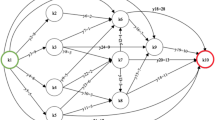Abstract
Zhang et al. (Optim. Lett. 15(21):2661–2680, 2021) investigated the maximum shortest path interdiction problem by upgrading edges on trees under unit Hamming distance, and gave the algorithm with time complexity \(O(N+l\log l)\) when \(K=1\) and the algorithm with time complexity \(O(N(\log N+K^3))\) when \(K>1\), where N, K and l are the number of tree nodes, the number of upgraded edges and leaves respectively. In this paper, we optimize Zhang et al.’s results and give a greedy algorithm with time complexity O(N) and a dynamic programming algorithm with time complexity \(O(NK^2)\). Meanwhile, based on this algorithm, we solve this problem with time complexity of \(O(N^3\log N)\) through binary search by upgrading the edges on the tree under the unit Hamming distance mentioned by Zhang et al. for the minimum cost shortest path interdiction problem. In addition, each edge can only be updated at most once in Zhang et al.’s model. Then, we consider a maximum shortest path interdiction problem by multiple upgrading edges on trees under gradient Hamming distance (MSPITMGH). And we extend Zhang et al.’s study by proposing a new model, in which each edge can be upgraded multiple times and the weight of edges can be dynamically increased step by step, however, such model cannot be solved by Zhang et al.’s algorithm. For the MSPITMGH, an algorithm with time complexity of \(O(NK^3)\) is given. Finally, we design numerical experiments to verify the correctness and efficiency of the proposed algorithms.




Similar content being viewed by others
References
Ahuja, R.K., Magnanti, T.L., Orlin, J.B.: Network Flows. Prentice-Hall, Englewood Cliffs (1993)
Albert, R., Jeong, H., Barabasi, A.: Error and attack tolerance of complex networks. Nature 406(6794), 378–382 (2000)
Khachiyan, L., Boros, E., Borys, K., Elbassioni, K., Gurvich, V., Rudolf, G., Zhao, J.: On short paths interdiction problems: total and node-wise limited interdiction. Theory Comput. Syst. 43(2), 204–233 (2008)
Corley, H.W., Sha, D.Y.: Most vital links and nodes in weighted networks. Oper. Res. Lett. 1, 157–161 (1982)
Nardelli, E., Proietti, G., Widmyer, P.: A faster computation of the most vital edge of a shortest path between two nodes. Inf. Process. Lett. 79(2), 81–85 (2001)
Frederickson, G.N., Solis-Oba, R.: Increasing the weight of minimum spanning trees. In: Proceedings of the 7th ACM-SIAM Symposium on Discrete Algorithms (SODA 1996), pp. 539–546 (1996)
Bazgan, C., Toubaline, S., Vanderpooten, D.: Efficient determination of the k most vital edges for the minimum spanning tree problem. Comput. Oper. Res. 39(11), 2888–2898 (2012)
Iwano, K., Katoh, N.: Efficient algorithms for finding the most vital edge of a minimum spanning tree. Inf. Process. Lett. 48(5), 211–213 (1993)
Zenklusen, R., Ries, B., Picouleau, C., Werra, D., Bentz, C., de Costa, M.: Blockers and transversals. Dis. Math. 309(13), 4306–4314 (2009)
Zenklusen, R.: Matching interdiction. Dis. Appl. Math. 158(15), 1676–1690 (2010)
Bazgan, C., Toubaline, S., Vanderpooten, D.: Critical edges for the assignment problem: complexity and exact resolution. Oper. Res. Lett. 41, 685–689 (2013)
Ries, B., Bentz, C., Picouleau, C., Werra, D., Zenklusen, R., de Costa, M.: Blockers and transversals in some subclasses of bipartite graphs: when caterpillars are dancing on a grid. Dis. Math. 310(1), 132–146 (2010)
Zenklusen, R.: Network flow interdiction on planar graphs. Dis. Appl. Math. 158(13), 1441–1455 (2010)
Altner, D.S., Ergun, Z., Uhan, N.A.: The maximum flow network interdiction problem: valid inequal ities, integrality gaps and approximability. Oper. Res. Lett. 38, 33–38 (2010)
Bazgan, C., Toubaline, S., Vanderpooten, D.: Complexity of determining the most vital elements for the p-median and p-center location problems. J. Combin. Optim. 25(2), 191–207 (2013)
Zhang, Q., Guan, X., Wang, H., Pardalos, P.M.: Maximum shortest path interdiction problem by upgrading edges on trees under hamming distance. Optim. Lett. 15, 2661–2680 (2021)
Denardo, E.V., Fox, B.L.: Shortest-route methods: 1. Reaching, pruning, and buckets. Oper. Res. 27(1), 161–186 (1979)
Acknowledgements
This work was supported by the National Natural Science Foundation of China (Nos. 72071202, 71671184 and 71971108), Top Six Talents’ Project of Jiangsu Province (No. XNYQC-001), Postgraduate Research & Practice Innovation Program of Jiangsu Province (No. KYCX22_2491) and Graduate Innovation Program of China University of Mining and Technology (2022WLKXJ021).
Author information
Authors and Affiliations
Corresponding authors
Additional information
Publisher's Note
Springer Nature remains neutral with regard to jurisdictional claims in published maps and institutional affiliations.
Rights and permissions
Springer Nature or its licensor holds exclusive rights to this article under a publishing agreement with the author(s) or other rightsholder(s); author self-archiving of the accepted manuscript version of this article is solely governed by the terms of such publishing agreement and applicable law.
About this article
Cite this article
Lei, Y., Shao, H., Wu, T. et al. An accelerating algorithm for maximum shortest path interdiction problem by upgrading edges on trees under unit Hamming distance. Optim Lett 17, 453–469 (2023). https://doi.org/10.1007/s11590-022-01916-3
Received:
Accepted:
Published:
Issue Date:
DOI: https://doi.org/10.1007/s11590-022-01916-3




